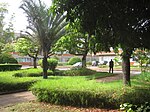Sirius (synchrotron light source)

Sirius is a diffraction-limited storage ring synchrotron light source at the Brazilian Synchrotron Light Laboratory (LNLS) in Campinas, São Paulo State, Brazil. It has a circumference of 518.4 metres (1,701 ft), a diameter of 165 metres (541 ft), and an electron energy of 3 GeV. The produced synchrotron radiation covers the range of infrared, optical, ultraviolet and X-ray light.Costing R$1.8 billion, it was funded by the Ministry of Science, Technology, Innovation and Communications (Brazil) and the São Paulo Research Foundation. Discussion started in 2008, and initial funding of R$2 million was granted in 2009. Construction started in 2015, and was finished in 2018. The first electron loop around the storage ring was achieved in November 2019. Its first experiments were made during COVID-19 pandemic at MANACÁ beamline, dedicated to macromolecular crystallography.Sirius is the second synchrotron lightsource constructed in Brazil. The first one, UVX, was a second generation machine operated by LNLS from 1997 to 2019.
Excerpt from the Wikipedia article Sirius (synchrotron light source) (License: CC BY-SA 3.0, Authors, Images).Sirius (synchrotron light source)
Avenida Giuseppina Vianelli di Napoli, Campinas
Geographical coordinates (GPS) Address Nearby Places Show on map
Geographical coordinates (GPS)
| Latitude | Longitude |
|---|---|
| N -22.807777777778 ° | E -47.0525 ° |
Address
Centro Nacional de Pesquisas em Energia e Materiais (CNPEM)
Avenida Giuseppina Vianelli di Napoli
13086-530 Campinas (Campinas)
São Paulo, Brazil
Open on Google Maps






